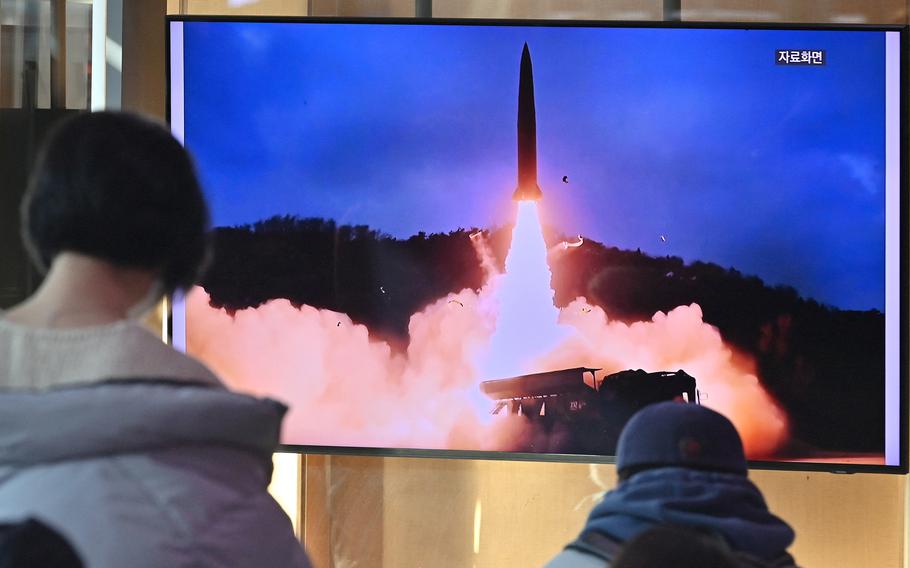
People watch a television screen showing a news broadcast with file footage of a North Korean missile test, at a railway station in Seoul on Jan. 30, 2022, after North Korea fired a "suspected ballistic missile" in the country's seventh weapons test this month according to the South's military. (Jung Yeon-Je, AFP/TNS)
CAMP HUMPHREYS, South Korea – North Korea launched at least two short-range ballistic missiles off its eastern coast Monday, a day after U.S. bombers carried out joint air drills over and near the Korean Peninsula.
Two missiles were fired from South Pyongan province at 7 a.m. and 7:11 a.m. toward the East Sea, or Sea of Japan, South Korea’s Joint Chiefs of Staff said in a message to news agencies. The missiles flew an estimated 242 and 211 miles.
The “successive ballistic missile launches are significant provocations that harm peace and stability on the Korean Peninsula,” the Joint Chiefs said.
Japanese broadcaster NHK, citing unnamed government officials, said the missiles appeared to fall outside the country’s exclusive economic zone.
The launches came two days after the communist regime fired an intercontinental ballistic missile — its first missile test since Jan. 1 — which the state-run Korean Central News Agency said was organized “suddenly” without prior notice by leader Kim Jong Un.
North Korea announced Saturday that the ICBM was a Hwasong-15 that flew at a maximum altitude of 3,584 miles and at a distance of 614 miles.
Kim Yo Jong, Kim’s sister and a senior party official, on Monday disparaged the South’s military and described the ICBM launch as a “surprise.”
“The frequency of using the Pacific as our firing range depends upon the U.S. [military] …,” she said in a statement released by KCNA.
The latest launch comes as South Korea’s Ministry of National Defense prepares to participate in a tabletop exercise in Washington, D.C., that includes a scenario addressing the North’s nuclear threat.
U.S. Defense Secretary Lloyd Austin, after meeting his South Korean counterpart last month, told reporters that joint drills will be increased “going forward” and that “you can look to see deeper consultation between our two countries and leadership.”
Pyongyang frequently criticizes joint drills between the U.S. and South Korea and views them as a rehearsal of an invasion. The regime’s Foreign Ministry warned in a statement Friday that the drills “seriously encroach upon the security interests” of the country and that Washington and Seoul would bear “strong counteractions.”
In response to Saturday's ICBM test, the U.S. sent B-1B bombers and F-16 Fighting Falcons to train over and near the Korean Peninsula with South Korean F-35A Lightning IIs and F-15K Slam Eagles. The drill was conducted in a “timely and immediately” manner, according to the South’s Ministry of National Defense.
Similar air drills were carried out that day with the Japan Air Self-Defense Force.
South Korean President Yoon Suk Yeol’s administration has vowed to meet the North’s provocations with displays of its own military might while leaving the door open for negotiations.
National Security Council spokeswoman Adrienne Watson in a statement from the White House on Saturday said the U.S. “strongly condemns” the ICBM test, which is “a flagrant violation of multiple U.N. Security Council resolutions."
North Korea fired one short-range ballistic missile on Jan. 1. It launched roughly 75 missiles in 36 separate days of testing in 2022, an annual record.